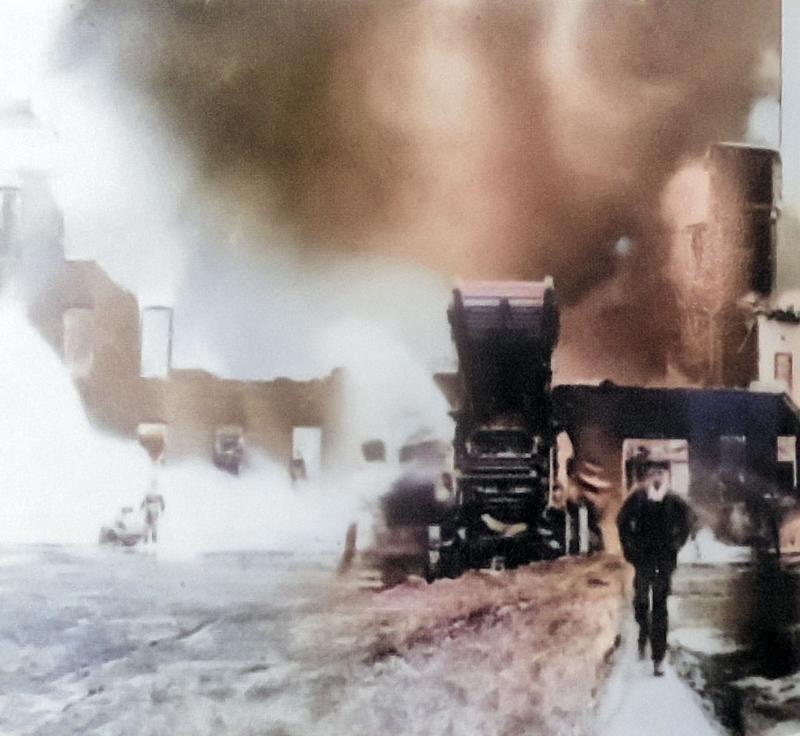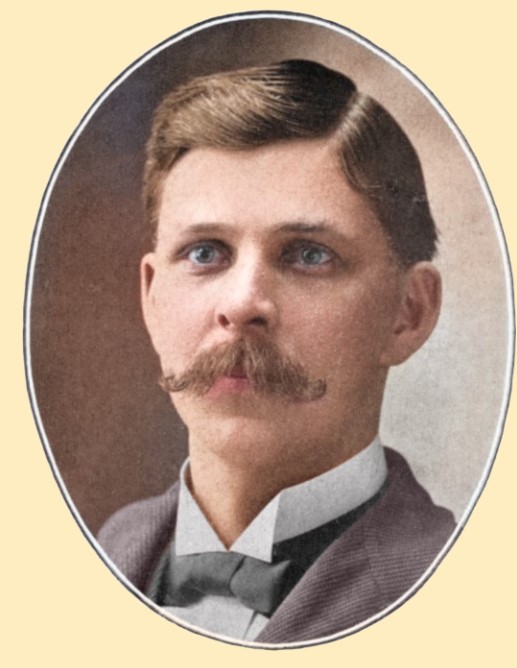Leading a parade down Michigan Avenue in East Lansing in 1907, Ransom Olds driving his REO Speed Wagon with President Theodore Roosevelt in the back seat behind him.
Olds was a master when it came to publicity so when he heard the president was coming, he shrewdly engineered this famous ride.
Ransom Olds - The Thinker
Olds was the holder of at least 34 U.S. Patents, among them
- patent for gas powered lawn mower
- patent for root extractor (to deal with the troublesome Palmetto roots in Florida
- Assembly line
- Pneumatic cushion tire
- Electric ignitor for gas engines
The massive Olds Motor Works at the turn of the century which stood at 1300 Jefferson Ave, Detroit. According to Ransom Olds, this was the first plant in the world built specifically to build automobiles. Everyone else was using existing buildings.
Hero of the Day - Olds employee James Brady managed to save the lone Curved Dash Olds, risking his own neck pushing it out of the fire and perhaps save the Olds name in the process.
Ransom Olds
The Quiet Dreamer
Ransom Olds was yet another of the forefathers of motor car innovation who should have his face on the automotive Mt. Rushmore (if there was such a thing) but like Louis Chevrolet and David Buick, their once famous names have been tragically and inexcusably relegated to some dusty, dark corner in the warehouse of history.
Like his automotive pioneering brethren, Olds did not sport an extensive formal education. Like Ford, Dodge etc, Olds' education came in the machine shop, so if you know how to fabricate, then what you can build is virtually limitless. Olds had a vision regarding horseless carriages which would propel him to legendary status. In many respects Olds seemed to be ahead of everyone, the pathfinder if you will, in the fledgling race to build 'America's car,' yet despite his astounding contributions to the auto industry, he wound up amongst the shadows of forgotten fame. Friend and rival Henry Ford may have perfected the assembly line but it was Ransom Olds who originated the idea in 1901 and was granted the patent for it. This enabled him to mass produce his Curved Dash Olds years before Henry's Model T. But first they had to sell the public on the virtues of the car over the time honored dependability of the horse.
Ransom Olds and wife Mette, in the custom of the day, tour Belle Isle in fashion in one of his prototype electric vehicles around 1901. Prior to his Detroit factory burning to the ground, Olds was the only car manufacturer who offered the trifecta of steam, electric and gas powered automobiles.
Women loved and greatly preferred the electrics because of there simplicity to drive. There was no cantankerous and noxious gas engine to deal with nor a clumsy boiler to light. Much like a golf cart, just put your foot on the pedal and go. They were also quiet and relatively free from vibration. A smooth ride indeed.
Even at this early stage of the automobile industry, however, Olds began to see the limitations of steam and electric. Steam took too long to start and electrics had a very limited range. As the quality and quantity of roads increased, people desired greater range from their vehicle which gas could increasingly provide. Also, the batteries of the day were very heavy and took too long to charge. Since the only charging stations to be found were in town, it wedded the electrics to short, local trips.
In the early afternoon of March 9th, 1901, there was an explosion at the Olds Motor Works factory which was followed in short order by two other explosions. It is believed that a natural gas leak, which went undetected, was the source. Since many of the factories in those days were made of wood, which as time went by soaked up the inevitable oil spills, the factory became an unquenchable blaze in minutes. Despite eight City of Detroit fire engines and the fireboat James Battle on the Detroit River, the fire simply out accelerated their fire fighting capacity.
Ransom Olds was also the first to use mass advertising to sell his cars. At the turn of the century it was a tough sell. For generations, horses had been a dynamo of energy for work and transportation around the farm or in the city.
Olds selling point for cars was, "It never kicks or bites, never tires on long runs, and never sweats in hot weather. It does not require care in the stable and only eats while on the road."
The smoldering ruins of Ransom Olds' Detroit factory which burned to the ground on March 9, 1901. Olds was just returning from vacation in San Diego when he stepped off the train and, to his stunned consternation, was handed a newspaper detailing the fire.
The factory was a total loss. Olds had a number of prototypes vehicles at the ready but was in a quandary as to which to put into production. Fate made the decision for him as the only vehicle saved from the fire was the Curved Dash Runabout.
With his manufacturing capability nullified, Olds cleared out his only remaining building, a foundry, and contracted numerous local fabricators like the Dodge boys to make his parts. They were then shipped to the foundry and assembled into vehicles. This was to set a precedent in the industry of contracting smaller firms to manufacture many of the parts and simply have them sent to the assembly plant to complete the finished product.
Sensing an opportunity, Lansing businessmen enticed Olds to move back to Lansing by offering up a 52 acre parcel in Lansing to build a new factory. The offer was too good to refuse and in 1902 Olds moved back to Lansing.
After 100 years of steam locomotives, it seemed to many of the auto pioneers at the turn of the century that steam powered cars was the obvious choice. There were certain niceties to be observed with steam power. After all, if a steam locomotive could pull 1000 tons it would certainly endow a car with enough stump pulling power to propel a handful of people to their destination. Steamers were also fast. Driver Fred Marriott drove a Stanley Steamer to a world speed record of 127 mph in 1906.
But there were issues with steam. Boilers must contain intense pressure and that means they must be heavy. Also, it took time to light a boiler and raise steam pressure in a world where people were increasingly demanding immediate gratification. So when the electric starter for the gasoline powered cars was perfected (eliminating the burdensome and dangerous hand crank) it proved to be a luxury the steamer could not defeat.
Ransom Olds (left) at the tiller of his steam powered automobile in 1892. The vehicle was so impressive for its day, it was written up in the Scientific American where a wealthy businessman in India saw it and bought it from Olds. The freighter that was shipping it sank on the way and this historic car is somewhere at the bottom of the ocean.
Ransom Olds (Blue suit) in 1936, now an elder statesman in the auto industry which he helped create, seen here leading a parade at Oldsmar, Florida, a city he helped create. While his name lives on in the surviving cars that he built, most notably the iconic Curved Dash Olds and the remnants of the few aging buildings scattered in Oldsmar and Lansing, it is a scant and unbefitting legacy for a man who was the first to put the world on wheels.
The car that made Ransom Olds a household name and preceded the renowned Model T by being the first mass produced car. It weighed in at a meager 700 lbs, has two forward and one reverse gears and with a stiff breeze at its back could top out at 20 mph. The curved dash idea came from the old horse drawn snow sleigh.
Ransom Olds demonstrating the ruggedness of his Curved Dash Runabout in tandem with the wretchedness of the Michigan roads. Irregardless of travel conditions, Olds never missed an opportunity to showcase his vehicle in front of a crowd of potential buyers. Olds, like P.T, Barham, was a bit of a showman. Whether it was flaunting his Curved Dash at the county fair or at a race track challenging his competition, the horse.
The fabled Curved Dash Olds of 1901
Never at a loss for ideas or an opportunity to advertise to improve his hand, Olds conjured up a Detroit to New York race of some 800 miles, a near infinity in those days of dubious cars, abysmal roads and few gas stations. If his Curved Dash Olds could complete the race it would be a coup of salesmanship. If he failed he would look like a fool and his driver, Roy Chapin, would likely be stuck in the middle of nowhere facing the indignity of being towed home by a horse, the very entity it was trying to defeat.
But Team Olds proved up to the challenge. Driver Roy Chapin, an enterprising character in his own right, decided to stick to the well trodden horse paths of the Erie Canal rather than chance the tumultuous road system. Eight days later, a mud splattered and exhausted Chapin arrived at the Waldorf-Astoria, although due to his disheveled appearance the doorman insisted he use the rear entrance, somewhat negating his glorious achievement. Olds stratagem helped him up the ante in the auto world while sequestering a book full of orders for his now famous car in the process.
Another hero in the Olds history was driver Roy Chapin who in 1901 displayed marathon stamina and acute driving skill by piloting this Curved Dash Olds from Detroit to New York in a mere eight days.
Chapin would go on the found the Hudson Motor Car Co. in 1908 in Detroit. He was also responsible for founding the Essex Car Co. Chapin was the prime mover for the formation of the Lincoln Highway which was one of the first transcontinental highways.
After leaving Hudson, he became the Secretary of Commerce for the Hoover administration.
Ransom Olds with his pockets turned out indicating he had had enough of Oldsmar. By 1923, having invested some 4.5 million ($66 million today) of his own money in an effort to develop his own Utopian wonderland, Olds finally gave up and moved on.
If there was any saving grace to the Oldsmar debacle it was that Olds unloaded his interests before the Florida land speculation went from boom to bust. Olds still incurred a $3 million dollar loss, some $44 million in todays dollars. While Olds continued to engage in numerous projects the rest of his life, his stint as an empire builder seemed to end with Oldsmar.
After Olds' departure, Oldsmar clung to life. Much like a forest that burns to the ground only to spread new seeds on the forest floor which slowly takes on new life. Today, Oldsmar sports a sprite 15,000 residents on its 6,400 acres. The name of Ransom Olds still looms large over Oldsmar. Of the millions of cars that bear his name, a handful still stubbornly display themselves on the streets of Oldsmar or beam proudly in the local museum. But Olds the man never really seemed to care about money or might but rather to leave a positive legacy behind him. This he accomplished. Ransom Olds died in 1950 at the venerable age of 86, always maintaining his life philosophy that virtue is its own reward.
A surviving Ransom Olds gas powered lawn mower for which he obtained the patent in 1915.
After immeasurable success in the auto industry, by 1913 Ransom Olds seamed to get bored with cars and turned his incredible imagination to other projects. He began scouting a large, Palmetto choked track of land north of Tampa Bay. In 1916 he purchased 37,000 acres of scrub brush land on the north part of Tampa Bay with the vision of creating a city along the lines of hometown Lansing. Olds was one of the first to foresee a getaway for winter weary Michiganians seeking to escape the cold, dreary winters. Olds planned to take advantage of the tropical climate. He envisioned a resort hotel with a private bathing beach in tandem with boating facilities on crystal blue canals lined with flowering oleanders.
Oldsmar may be a long way from Detroit but not far enough to not recognize street names like Woodward, Jefferson and Congress. Olds brought his roots with him in designing Oldsmar. It was to be a "working man's" paradise. A combination of factories and farms would provide comfortable employment for its inhabitants who could look forward to enjoying the ocean life and its many amenities. Olds chartered trains to take perspective buyers from Michigan to Oldsmar where his salesmen awaited to work their magic
where working class houses around $1,500 ($34,000 today) would be built.
While there was some initial success in attracting adventurers looking for something different, too many thorny obstacles seem to always block the path to success and despite a Herculean effort by Olds, he was ultimately unable to overcome them. Olds desperately tried in 1917 at the height of WW1 to attract a federal government shipyard at Oldsmar which would have spurred employment but did not have enough clout to pull it off. Initially motorist heading south or west to Tampa had to pass through the Oldsmar area. When other roads were built to Tampa circumventing Oldsmar, a vital artery necessary for survival was severed.
Unlike today where new cars are rolled off the assembly line and driven on to a train or truck for shipping, Olds insisted that all new vehicles under go specific tests to verify that everything was functioning properly prior to shipping. When the city of Detroit began excavating canals on Belle Isle, the large mounds of earth left behind created an inviting hill test. Since test tracks had not been invented yet and Detroit itself was totally flat, the Belle Isle man made hills were put to good use. Since the Olds factory stood at the foot of the Belle Isle bridge, it was a short trip.
(Left) Olds test driver Roy Chapin drives a new Curved Dash Runabout up the hills of Belle Isle to test the drive train, suspension and brakes.
The "Unnamed" Hurricane of 1921
Though Ransom Olds put considerable time and effort into Oldsmar, the progress was not proportional. While the creation of bridges in the Tampa area had the negative effect of diverting people away from Oldsmar, it was the devastating hurricane of 1921 (they did not name hurricanes until 1953) that devastated Oldsmar temporarily putting in under water and perhaps sealing its fate for good. Like one of his early steam powered cars, the steam to propel the development of Oldsmar seemed to run out on Ransom Olds.
The devastating hurricane of 1921 did significant damage to the Tampa Bay area and thus to Oldsmar.
Your Choice - 1903
It must be appreciated that 'horseless carriages' in 1903 were in their extreme infancy and were only seen as a better and perhaps a more stylish alternative to the horse. While there were a slew of choices a buyer could select from, these are just some of the alternatives to the Curved Dash Olds. They range from the luxurious and stylish Northern runabout to the unpretentious, short range grocery grabber manufactured by Canda.
It was once said by a French critic that when choosing a car in those days, the English looked at the gearing, the Germans looked at the engine but the Americans looked at the price. The well-to-do, of course, have never been terribly concerned when it comes to price but they were few in number. The bottom wrung fringe buyer were great in number if the manufacturer could make their vehicle inexpensive enough. The cars of early 1900 were essentially still a horse buggy with an engine substituting for the horse. It was crude but it was a beginning.
1903 Northern Runabout
Price: $800 $29,750 in 2024
1903 Orient Buckboard
Price: $375 $10,714 in 2024
1903 Curved Dash Olds
Price: $650 $18,571 in 2024
1903 Crestmobile
Price: $550 $15,714 in 2024
1903 Locomobile (Steamer)
Price: $600 $17,142 in 2024
1902 Canda Quadracycle
Price: $195 $5,571 in 2024
A crude road through the endless Cypress trees shows what Ransom Olds was up against in developing Oldsmar. Olds tried to induce farming into the area, boasting that because of the suburb climate, " I can see no reason why we can not three or more crops a year from this fertile soil." He also envisioned a grape industry in Florida and since the growing season was longer in Florida, the grapes would mature quicker and they could get the drop on their Californian competitors. Despite the abundant agricultural virtues of the state of Florida, grape production was yet another interesting concept from Ransom Olds that never really caught on in Florida.
Once a year in the spring, Oldsmar residence reminisce about Ransom Olds' legacy and celebrate with Oldsmar Days and Nights, where old cars meet up with to make new memories.































